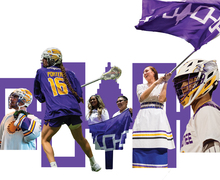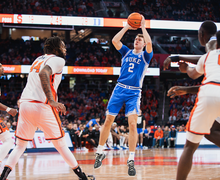Students call for transparency in FYS 101, inclusion of #NotAgainSU protests
Meghan Hendricks | Asst. Photo Editor
First-year students were not educated on why the course was created in the first place and how the protests led by hundreds of Black students created change at the university.
Every dollar donated during December will go directly toward paying students to produce stories like this one. Give now and ensure a brighter future for The Daily Orange.
After occupying Crouse-Hinds Hall for 31 days in March 2020, #NotAgainSU demanded Syracuse University proactively prevent discrimination and bias-related incidents.
The protest demanded a new and improved course to replace SEM 100 that would more effectively educate students about diversity, equity and inclusion. But the movement that asked for the new first-year seminar was left out of the course curriculum.
SU undergraduate students critiqued the stark similarities between SEM 100 and FYS 101 throughout the semester, saying there were little to no changes between the two courses. Most notably, first-year students were not educated on why the course was created in the first place and how the protests led by hundreds of Black students created change at the university.
“FYS 101 seems to contain all the bad qualities that we advocated against in SEM 100,” said Adia Santos, an SU student who helped organize the #NotAgainSU protests. “FYS 101 was meant to be an entirely new course, one that actually incorporated DEIA lessons and professionals. … The course is entirely ineffective, problematic and encourages students in underrepresented communities to teach the course themselves.”
Santos said she heard some classes showed a video created by the university about the protests, but the video was created without asking for the organizer’s input. This video seems entirely inaccurate and unfair, Santos said.
Bianca Eguzo, a first-year student in the FYS 101 course this fall, said her class never mentioned the protests or explained why the course was created.
Alex Jenkin, a first-year biotechnology major, said her class brought up “#NotAgainSU” but didn’t discuss the protests or the demands of the students. She said she felt the university missed an opportunity to better inform students by discussing the protests.
Jenkin said her class section made little effort to introduce the history of #NotAgainSU. She said it’s important for students to know more about the university’s history and to understand discrimination can happen anywhere.
“Learning from the university’s past mistakes decreases the chances of them happening again,” Jenkin said. “You can’t really talk about discrimination and bias without talking about the university’s history with it.”
Kirsten Riley, a junior and peer leader for the course, said she noticed the course barely brought up #NotAgainSU. Teaching about the protests will make more people have a better understanding of the material since they’ll know why they are learning it, Riley said.
Eguzo said while the course didn’t discuss the protests, she believed the course did promote diversity and inclusion. She said she thought the class would be more about helping students integrate into SU instead of bias prevention.
“The class is more tailored to (diversity and inclusion) than helping with the first-year experience, which is a little bit more of what was advertised for the course,” Eguzo said. “I didn’t even know the intent (behind the course), however, bias and diversity are definitely discussed in the course a lot.”
More coverage of FYS 101:
- FYS 101 shares fall 2022 objectives amid student concerns over course content
- SA committee suggests more transparency, FYS 101 reform in SU’s DEIA plan
- Students voice frustration with recent DEIA plan in meeting at 119 Euclid Ave
SU’s Student Association held a town hall on Nov. 11 to discuss the university’s five-year Diversity, Equity, Inclusion and Accessibility draft plan. During the event, students expressed frustration about FYS 101, saying the course would’ve been the perfect opportunity to talk about the plan, though it was not included.
Students also said they felt the course forced students of color to share their experiences and teach the class, making their trauma the center of the course’s material.
These ideas were reiterated last week when SA held a meeting in conjunction with 119 Euclid Ave., where students of color expressed how the course content barely mentioned the protests. Later that week, SA released a list of recommendations for the draft DEIA plan, explaining that the leaders of #NotAgainSU should be involved in creating the course content.
Current first-year students said they felt the course failed to make an impact. Jenkin said the course was far too academic, with classes consisting of reading articles and watching videos rather than holding meaningful discussions about diversity and inclusion.
“These (articles and videos), in my opinion, don’t do that great of a job of enforcing what is trying to be learned,” Jenkin said. “The class should be way more discussion-based, rather than read articles and watch videos that we’ll likely forget within 30 minutes of leaving the class.”
Santos said the course does not achieve its intended goal of promoting diversity, equity, inclusion and accessibility. She said students get little to nothing out of the course and its content and the course isn’t contributing to anybody’s academic or personal development.
“The course is a way for the university to let go of their responsibility to incorporate DEIA elsewhere during our time here,” Santos said. “This school can teach you a lot of hard lessons, and FYS 101 does nothing to prepare you for that.”
Riley said she saw the course as a large improvement from the previous versions of SEM 100. She said since the course allowed for flexibility between the peer leader and lead instructor, she could help her section bond, allowing for better discussions to take place.
Riley’s class section went ziplining as an outdoor bonding activity, which fostered a deeper connection between the students. The class focused more on diversity and inclusion, which she knew to be the course’s intent, and there were even a few times they couldn’t finish the class content because discussions would last too long, Riley said.
Even though some students felt the course attempted to discuss diversity and inclusion in meaningful ways, many felt the university dropped the ball.
“DEIA education is not a one-time process, it should be at the foundation of our curriculum and experience (at SU),” Santos said.
Published on December 9, 2021 at 12:55 am
Contact Karoline: kaleonar@syr.edu






